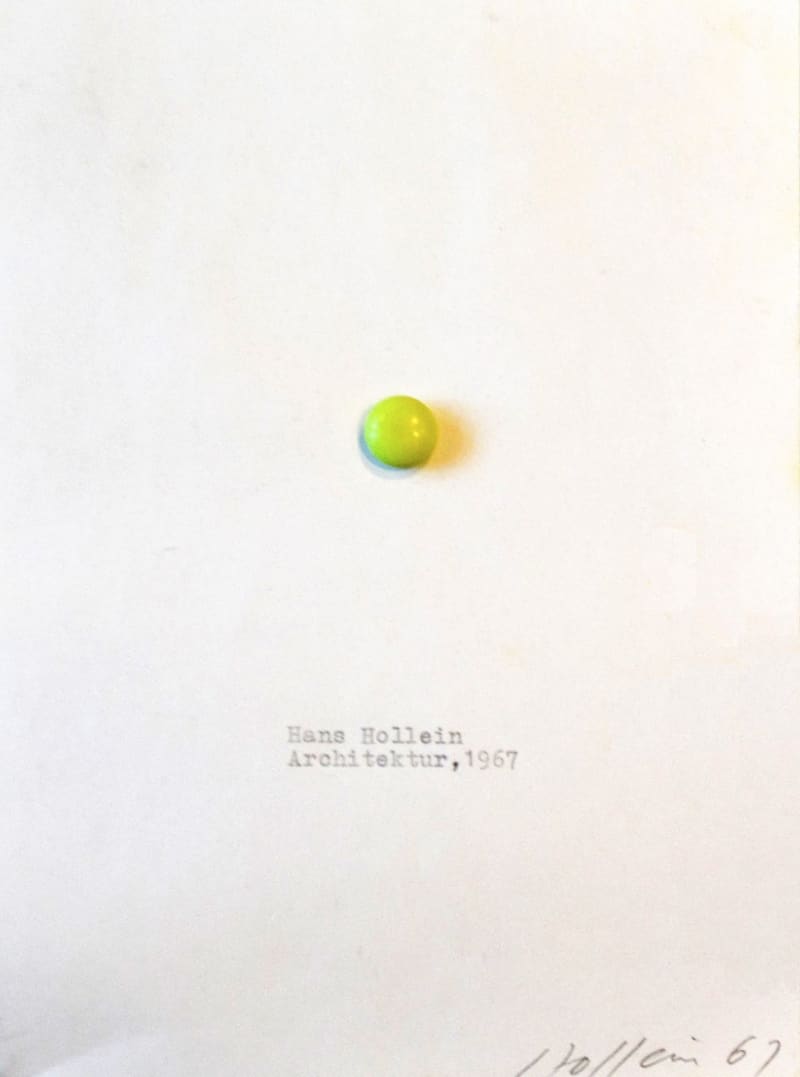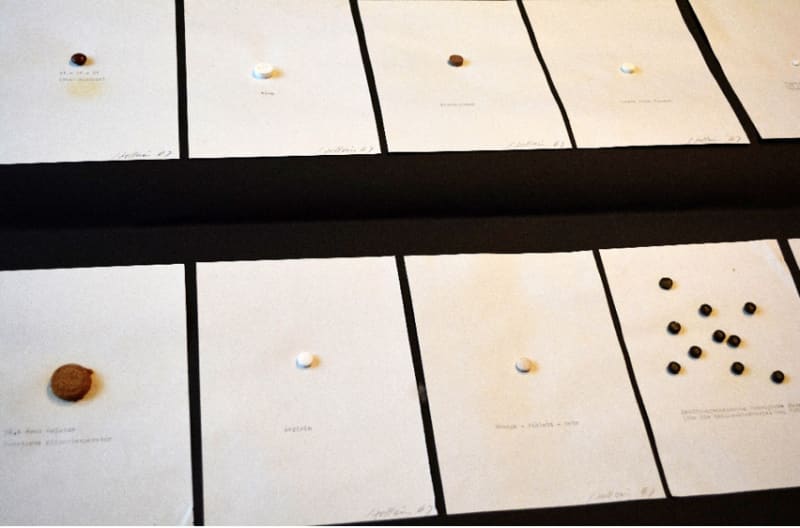The Architecture Pill: by Eva Branscome

A guest article by Eva Branscome, Bartlett School of Architecture, University College London
In 1967 the Austrian architect Hans Hollein stuck a glazed green pill to a sheet of A5 stock paper and typed his name and the year below, adding to this the word *Architektur *and his handwritten signature. This was the same year that he declared ‘Alles ist Architektur’ (‘Everything is Architecture’), suggesting that the traditional notion of built things made up of walls, ceilings and roofs needed radical rethinking. Hollein understood architecture at large as being environments created by human beings, writing in his provocative manifesto:
“The human creates artificial conditions. That is architecture. Repeated physically and psychologically, he transforms and expands his physical and psychological realm, he determines his “environment” in the widest sense.”
“According to his needs and his desires, he employs means to satiate these needs and to fulfil these wishes and dreams. He expands himself and his body. He communicates himself.”
Hollein thus opened up the very concept of what constitutes architecture, going beyond the conventional understanding of advances in building materials and methods, to embrace media, ritual, psychology, science and technology – and also the night-time dream and the spatio-emotional experience of the orgasm.
At its basic level, Hollein understood architecture as to do with the protection and control of human body temperature. In this sense, 1960s architecture for him could be contracted down to the minimal environment of the space suit, with its in-built supply lines. Yet also impatient with dependence on physical ‘building materials’, Hollein pointed out:
“Few attempts have been made to define our environment and determine our space with other physical means (such as light, temperature, smell). While the application of conventional methods has widespread options for expansion, those of lasers (holographs) can hardly even be predicted. Finally, there have been practically no studies for the selective use of chemicals and drugs, in terms of the control of body temperature and body functions, as well as for the artificial creation of environment. Architects must stop thinking only in materials.”
His project, titled Nonphysical Environmental Control Kit, to which the architecture pill belonged as a series of ‘multiples’, explained: ‘The Kit contains different pills which create various desired environmental situations.’ It was all part of Hollein’s declaration to dematerialize – and thereby enhance and expand – architecture into infinitely wide human perceptions.

While pills have of course existed since ancient times, dating back to around 1500 BC, as a means to deliver measured doses of medication, psychoactive drugs were first used extensively by all the major military powers during the Second World War to fend off sleep deprivation, fear, hunger and emotional compassion, while boosting concentration, memory and reflexes. Once the war was over, the use of such stimulants quickly migrated from military use into everyday life – most famously with Valium (diazepam) becoming ‘mother’s little helpers’ in the late-1960s, albeit also frequently used by businessmen. Particularly in the USA, pills became part of modernity and the new consumer lifestyle. Unlike alcohol and other such stimulants, the use of these pills was socially acceptable, as discreet fixes, with their consumption being facilitated by the medical profession and also openly promoted on American TV series. During the 1950s and 60s, LSD and the birth-control pill became popular as lifestyle enhancers, albeit in two completely different social and political realms.
Hollein’s project needs to be understood within this pill-popping context, and yet went beyond it. For him, the pill also represented a kind of condensed essence. As he explained in a 2009 interview:
“I invented the “architecture pill”. At that time, pharmaceuticals were developed which overcome claustrophobia or agoraphobia, which allowed rooms to appear less threatening by enlarging or reducing them perceptually. I imagined that one might even be able to produce images of architecture with pills, and I exhibited pills that I named, for example, “Hagia Sophia”, “Sydney Opera” or “Stonehenge”. The term architecture has been expanded in every direction, and my sentence “Everything is architecture” haunts me to this day.”
The pill-pages in Hollein’s *Nonphysical Environmental Control Kit *are still held in his private archive in Vienna. Some are fairly straightforward. There is one for example titled ‘Aspirin’ which we all can relate to. It helps to remove pain as well as fever, whereas another is titled more directly ’36.4 Degrees Celsius, constant body temperature’. Then there are two pages concerning the female body, something that Hollein always conceived of as an architectural environment. ’91–56–91 (Miss Austria)’ was about maintaining the perfect female bodyweight, while ‘Love without fear’ alluded to the birth control pill, which made sexual pleasure a less risky endeavour. Pages with a pill stamped ‘King’ (perhaps a sugar candy, perhaps not) and ‘Happiness’ (two saccharin tablets still encased in cellophane wrappers labelled as Sacrinpak), were about emotional enhancement. And if they didn’t work, there was one for ‘Death’.
There are also several pill-pages to do with Austrian cultural identity, since that was another recurring concern of Hollein’s. Those dedicated to aesthetic experiences include ‘Wolfgang Amadeus Mozart, Kleine Nachtmusik’ and ‘Alpine glow’, both unquestionably sublime. ‘Wiener schnitzel with potatoes and mixed salad’ is arguably also part of this, although might well have more to do with indigestion. There is one titled ‘Orange–Violet–Green’ that remains perplexing, perhaps being about the popular colours of psychedelics. The pill itself is white and lightly speckled and looks suspiciously like the one for ‘Death’.
Some are more conventionally architectural, including the pill-page ‘Chapel, Church, Cathedral’. Here some brown bean-shaped sugar-coated pills are arranged as a configuration with one at the top, two in the next line, and then three below, resembling a simplified spire and also suggesting the relative experience of scale and spiritual intensity. Catholicism always figured strongly in Hollein’s work, but although he drew designs for hundreds of churches, none was ever built, remaining for him an unfulfilled aspiration. In contrast, the pill for ‘Single family home in rural setting’ is an ironic reference to the architect’s own frustration and impatience about his career, perhaps making this kind of banal commission more tolerable or providing creativity and inspiration in times of desperation.
In 1968, just a year later, Ron Herron of Archigram created two colourful collages called the ‘Enviro-Pill’. In my interview with Hollein in 2010 he refused to talk about his various interactions with the British architectural group. Disappointment was still raw decades later that his idea had been in effect ‘pill-fered’. But while there were clear overlaps, Hans Hollein’s projects were not about the erasure of built architecture, as in the vision of Archigram’s David Greene, but instead its expansion and enhancement. From his early work in the 1960s through into the 80s, Hollein strove to introduce dimensions to architecture that had been previously excluded from a Modernist discourse focussed on functionalism and cultural homogeneity.
Hollein was indeed right: the pill, and its consequent drug experience, can be seen as architecture in the sense that it creates a spatial and cultural conduit, a medium and a dream.
Eva Branscome, Hans Hollein and Postmodernism: Art and Architecture in Austria, 1958-1985. Routledge: London and New York, 2018
Pill-pages from the *Nonphysical Environmental Control Kit *are held by the Generali Foundation in Salzburg, Austria and by the Centre Pompidou in Paris
Hans Hollein, ‘Alles ist Architektur‘, Bau, 1/2 (1968), translation by author
Horst Christoph and Patricia Grzonka, ‘Stararchitekt im großen Interview‘, Profilonline, 26 March 2009, translation by author